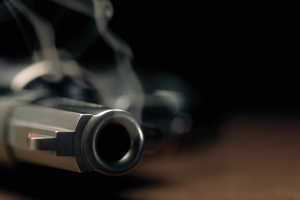
CHAPTER 8
SCHOOL SHOOTERS AND WORKPLACE KILLERS
MANY AMERICANS ARE ALIENATED, FRUSTRATED, ANGRY, AND OFTEN DEPRESSED. BUT THEY DON’T TURN ON OTHERS WITH GUNS. WHAT TRIPS THE TRIGGER?

Since 2006 the rate of mass shootings has more than doubled, according to the Federal Bureau of Investigation.
MURDER BY THE NUMBERS
HOMICIDES HAPPEN IN ALL CORNERS OF THE GLOBE, BUT BY WHAT MEANS AND HOW OFTEN VARIES DRAMATICALLY.

source: UNODC: Global Study on Homicide, 2013
• In the U.S., 60 percent of murders are committed with a gun.
• Tegucigalpa, Honduras, had 1,175 homicides in 2011, more than one per 1,000 citizens.
• Port-Au-Prince, Haiti, had 495 homicides in 2010—about 40 per 100,000 people.
• In England and Wales, 40 percent of homicides were committed with sharp objects in 2011–2012.
• In South Africa, 57 percent of female victims are slain by their husbands or partners.
• In Finland between 2003 and 2006, 22 percent of murderers were under the influence of drugs and/or alcohol.
• In India, 40 percent of murder victims are female.
• In China, about a quarter of murders in 2010 were committed with a sharp object.
• Japan’s annual murder rate—about one per 300,000 people—is tied with Iceland’s.
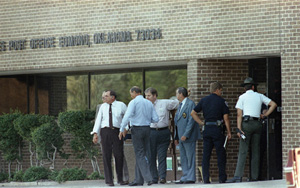
Members of the Edmond Police Department gather in front of the Edmond Post Office, where Patrick Henry Sherrill systematically killed 14 people before killing himself, 1986.
There were 437,000 murders worldwide in 2012, according to the United Nations Office on Drugs and Crime. But any one person’s likelihood of becoming a victim depends on who he is and where he lives. Most victims of murder—79 percent of them worldwide—are male. The majority are between the ages of 15 and 29, and living in the Americas. Men also make up the vast majority of perpetrators, committing 95 percent of killings globally.
Though murders of women are much less common, the biggest danger is from someone the victim knows and loves. Almost half of the 93,000 women murdered in 2012 were killed by a family member or a romantic partner. Only 6 percent of men are killed by someone close to them.
As for the most common murder weapon: It’s guns, which were used in 41 percent of all murders and 70 percent of mass murders. A third of all homicides were committed by “other means,” including beating, poisoning, and strangulation. Sharp objects such as knives and machetes were used in slightly less than a quarter of all homicides.
Access to Guns
According to research, the availability of guns does affect murder rates. In one study, European countries in which fewer than ten percent of households owned a gun had about one murder per half a million people. In European countries in which more than 15 percent of households owned a gun, there were about three murders per 200,000 people.
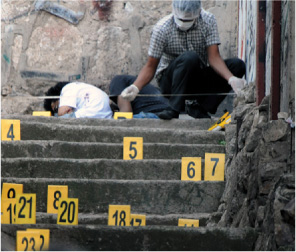
A crime site in Honduras, where four young people were shot dead in 2013
THE WORLD’S MOST DANGEROUS PLACES
According to the United Nations, the following countries have the world’s highest homicide rates:
• Honduras: 90 murders per 100,000 people
• Venezuela: 54 murders per 100,000 people
• Belize: 45 murders per 100,000 people
• El Salvador: 41 murders per 100,000 people
• Guatemala: 40 murders per 100,000 people
GOING POSTAL
EXPERTS CHALK UP WORKPLACES RAMPAGES TO JOB STRESS AND EASY ACCESS TO DEADLY WEAPONS.
At about 7 AM on August 20, 1986, mail handlers in Edmond, Oklahoma, were busy sorting the letters and preparing for their morning routes when postman Patrick Sherrill, wearing his uniform and carrying three handguns, walked in. Sherrill never said a word as he strode through the building shooting employees. As he passed through each room, he locked the doors behind him so that no survivors could escape. He paused only to reload his weapons. By the time Sherrill turned one of his guns on himself, he had killed 14 people and wounded six; it was not even 7:30 AM.
The incident was one of the first of a series of violent sprees involving U.S. Postal Service workers. Soon, people began to use the expression “going postal” to refer to episodes of work-related rage that segued into violence. The stereotype of the potentially homicidal postal worker became so widespread that the U.S. government established a commission to investigate.
“Going postal is a myth, a bad rap” ’ concluded Joseph Califano Jr., the head of the commission. “Postal workers are no more likely to physically assault, sexually harass, or verbally abuse their coworkers than employees in the national work force.” Experts went on to point out that homicides committed by postal workers simply received more press than other violent workplace incidents because of the public and commonplace nature of mail delivery. The notion of a mailman gone mad seemed to tap into some basic fear or fascination, but workplace violence has never been confined to any one occupation.
WHO KNEW?
From 2003 to 2012, more than half of workplace homicides took place in three occupation classifications: sales, protective services, and transportation and material moving.
Danger: Men at Work
In the United States alone, there were 14,770 workplace homicides between 1992 and 2012; that’s an average of more than 700 per year. What turns a disgruntled worker into a killer? Investigators claim to have identified certain conditions that seem more likely to breed workplace violence. These include the following:
• Contact with the public
• Exchange of money
• Delivery of passengers, goods, or services
• Having a mobile workplace such as a taxi or a police car
• Working with unstable persons in health care, social service, or criminal justice settings
• Working alone or in small groups
• Working late at night or during early morning hours
• Working in high-crime areas
The most common connection among employees who become violent seems to be a change in employment status. An unfavorable review, a decrease in hours, the threat of termination, or termination itself can all trigger an unstable employee to react violently. Patrick Sherrill, for example, had been reprimanded by two supervisors the day before his murder spree. One of them was the first person he shot.
Obviously, not everyone who is scolded by a boss resorts to murderous revenge. But negative encounters with authority figures do seem to be a common link. The availability of firearms (75 percent of these incidents involve guns), combined with work-related stress and the erosion of job security, form the deadly equation of workplace violence.
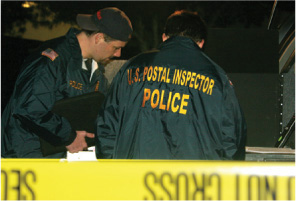
Police investigate the crime scene at a U.S. Postal Service distribution center in Goleta, California.
THE SHOOTERS
Killings inside U.S. Postal Service offices loom large in the public imagination.
• Ridgewood, New Jersey. In 1991, a former U.S. postal worker, enraged about his dismissal, killed his former supervisor and her boyfriend at their home. The next morning, the 35-year-old Navy veteran stormed the post office, armed with a machine gun, a samurai sword, three hand grenades, and some homemade bombs. Before surrendering, he killed two mail handlers.
• Royal Oak, Michigan. In 1991, an ex-Marine and former postal clerk, furious that he had been dismissed, walked into a postal center and opened fire with a sawed-off .22-caliber rifle. He killed three workers and wounded six before shooting himself.
• Goleta, California. In 2006, a former postal employee with a history of mental illness killed six postal employees at a mail-processing facility before committing suicide with a handgun. This was one of the deadliest American workplace shooting incidents ever carried out by a woman.
COMING HOME
SOLDIERS ARE TAUGHT TO KILL IN WARTIME, BUT DO THEY BRING MURDEROUS TENDENCIES BACK?
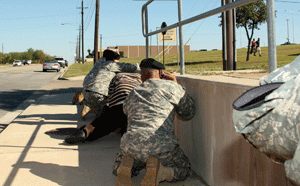
Bystanders and soldiers crouch for cover as law enforcement officers (upper right) run toward the sound of the gunfire at the Soldier Readiness Processing Center at Fort Hood, Texas, in 2009.
WHO KNEW?
Former Navy SEAL and best-selling author Chris Kyle, who called himself the “most lethal sniper in U.S. history,” was killed along with another man at a Texas gun range. The suspect, Eddie Ray Routh, is an Iraq war veteran who claims to be suffering from PTSD.
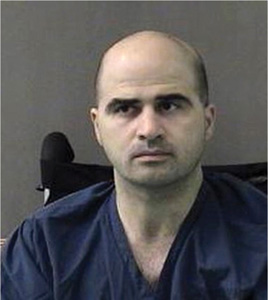
Nidal Malik Hasan, a U.S. Army major, fatally shot 13 people and injured more than 30 at Fort Hood, Texas.
U.S. Army major Nidal Hasan’s murderous shooting spree at Fort Hood in Texas was ghoulishly historic: It resulted in more casualties than any other attack by a fellow service member on a U.S. military base. At his court martial in 2013, Hasan was found guilty of premeditated murder and sentenced to death.
Post-Traumatic Stress Disorder and Violence
Although some politicians described Hasan’s shootings as an act of terrorism, the U.S. Department of Defense and federal law enforcement agencies classified the event as workplace violence. In recent years, there have been several such high-profile attacks at U.S. military bases. In many of the attacks, the shooters seemed to suffer from post-traumatic stress disorder, or PTSD.
The term PTSD describes a constellation of mental health problems triggered by experiencing or witnessing terrifying events. It is most often diagnosed in soldiers returning from combat, though victims of abuse or other crimes are common sufferers as well. Symptoms of PTSD may include flashbacks, nightmares, severe anxiety, and violence. Most people who have experienced a traumatizing event will not develop PTSD, but about 7 percent of American adults suffer from the condition, including more women than men.
Multiple studies have cast light on the struggles faced by soldiers returning home. A 2010 study funded by the U.S. Marine Corps surveyed 1,543 marines with at least one combat tour and found that those who had reported PTSD symptoms were more than six times as likely to engage in antisocial and aggressive behaviors as those who did not report PTSD symptoms.
Another study in 2012 looked at more than 1,000 combat veterans and found that about 23 percent of those with PTSD and high irritability had been arrested for a criminal offense. This was more than double the rate of all the combat veterans studied, including those with and without combat trauma.
The link between PTSD and crime is worrisome. In response to an apparent clustering of homicides at Fort Carson, Colorado, the U.S. Army’s third-largest post, the military commissioned a report. Issued in 2009, the 126-page study found that the murder rate around the post had doubled, and that the number of rape arrests had tripled between 2005 and 2008.
While it is inaccurate to claim that all combat veterans have PTSD, or that PTSD causes violence, there is at least some link between PTSD and postwar homicide. Serving in a war zone exposes people to serious psychological and moral challenges, and that experience has the potential to make some people less stable and more violent than they might have otherwise been.
BASE ATTACKS
Although unprecedented in scale, Major Nidal Hasan’s killings at Fort Hood were not unique.
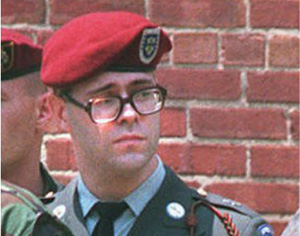
Lawyers for shooter and paratrooper William Kreutzer Jr. claimed he had mental health issues.
In 1995, William Kreutzer Jr., a U.S. Army paratrooper, killed one soldier and wounded 18 others when he opened fire on a physical training formation at Fort Bragg, North Carolina.
In 2003, at Camp Pennsylvania in Kuwait, U.S. Army soldier Hasan Akbar threw hand grenades into a tent in the early morning, when most troops were sleeping. He then fired his rifle into the subsequent bedlam; two soldiers were killed.
In 2009, at Camp Liberty in Iraq, John M. Russell, a sergeant, was being escorted back to his unit after a visit to the combat stress clinic at the camp when he grabbed an unsecured rifle. He then drove back to the counseling center and opened fire on unarmed fellow service members, killing five. He survived and was convicted of the killings.
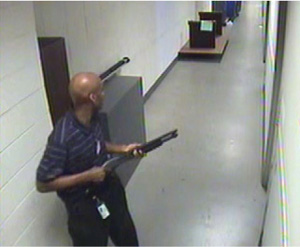
Navy subcontractor Aaron Alexis was delusional said the FBI.
In 2013, Aaron Alexis, a subcontracted technology worker at a navy facility, fatally shot 12 people and injured four others inside the Washington Navy Yard in Washington, D.C. It was the second-deadliest mass murder on a U.S. military base, behind the 2009 shooting at Fort Hood, Texas. Alexis was killed at the scene.
In 2014, there was a second mass shooting at Fort Hood, in which three were people killed and 16 others wounded. The gunman, 34-year-old Ivan Lopez, an Iraq war veteran, died of a self-inflicted wound.
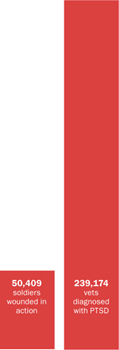
WAR WOUNDS
Studies show PTSD is much more common among U.S. veterans than physical wounds. Experts have diagnosed the condition …
• In 11 to 20 percent of veterans of the Iraq and Afghanistan wars.
• In as many as 10 percent of Gulf War Veterans.
• In about 30 percent of Vietnam veterans.
CAMPUS KILLERS
MANY SCHOOL SHOOTERS SUFFER FROM SEVERE EMOTIONAL TRAUMA, PSYCHOSIS, OR MENTAL ILLNESS.
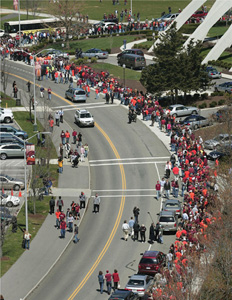
Thousands of Virginia Tech students wait in line to attend a memorial service in honor of those killed in the shootings of April 17, 2007, in Blacksburg, Virginia.
Violent media images and video games, bullying, and mental illness have all been cited as factors in school shooters’ psychological profiles, but it is difficult to pinpoint a primary cause of the bloodshed. Many students are subject to these influences and don’t kill classmates. It is more accurate to say that these mass attacks result from a combination of clinical and sociocultural elements.
School shooters are typically portrayed as shy, aloof loners who react violently to prolonged bullying or humiliation. But psychologist Peter Langman, who evaluates youths at risk, suggests this stereotype is wrong. Instead, Langman suggests that these individuals suffer from disturbing, unbearable, often misunderstood psychological problems. He divides them into three categories:
1. The traumatized, full of hostility and shame
2. The psychotics, driven by paranoid delusions
3. The psychopaths, mainly motivated by sadistic ideologies
Traumatized individuals tend to have violent fathers, while substance abuse and parental rejection are common among psychotics, writes Langman in Why Kids Kill: Inside the Minds of School Shooters. Psychopaths often are more sadistic than their peers and have been immersed in gun culture. Not all kids who commit mass murder come from difficult homes, however. And while some are loners, others are surrounded by friends.
Most school shooters kill themselves afterward and intend to do so from the beginning. This makes them especially dangerous because they are unafraid of punishment. The school environment, which represents the existing social order, becomes the target of seething anger and revenge in a bid for recognition. Some experts believe shooters attack children and teenagers because they’re easier to control than adults, who appear more threatening.
Snapshots of Notorious Shooters
Violence researcher Jack Katz of the University of California, Los Angeles, says some shooters inflict “righteous slaughter” to right past wrongs. Seung-Hui Cho, the Virginia Tech student who massacred 32 and injured 17 in April 2007, was said to have had an uneasy relationship with his fellow students. In the middle of the shooting spree, Cho returned to his dorm to mail photos, writings, and homemade videos denouncing hedonism and materialism to NBC News. A note found in his room condemned “rich kids.”
Columbine killers Eric Harris and Dylan Klebold were also different from their peers. Klebold was depressed and troubled. Harris, extremely self-conscious about “bodily defects,” was fascinated with Nazi leader Adolph Hitler’s master race concept. The two shared sadistic, suicidal fantasies. In their diaries, they depicted themselves as wrathful gods.
Some shooters develop an all-consuming rage at life and attack schools with no apparent reason. It is unknown, for example, why 20-year-old killer Adam Lanza chose his former grade school, Sandy Hook Elementary, as his target. Lanza reportedly had been diagnosed with sensory integration disorder as a child. He had a history of obsessive-compulsive behaviors, including changing his socks 20 times a day, and was interested in advocating for pedophiles’ rights. He was fascinated by military and school shootings, especially Columbine.
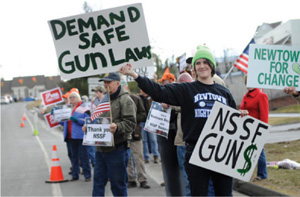
Gun control supporters and opponents gather outside the National Shooting Sports Foundation in Newtown, Connecticut, in 2013.
THE GUN QUESTION
Arming the defenders
A heated public debate on gun ownership followed the December 2012 massacre in Sandy Hook, Connecticut. The National Rifle Association responded to calls for restrictions by suggesting schoolchildren would be safer with armed security personnel. A total of 33 states considered new bills to arm teachers and administrators, but as of August 2014 only eight had enacted such laws, while gun laws were strengthened in 15 states.
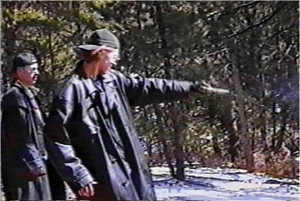
Eric Harris (left) watches as Dylan Klebold practices firing a gun. Both committed suicide after massacring classmates at Columbine High School in Colorado in 1999.
PREVENTING THE VIOLENCE
How should schools work to keep another Sandy Hook from happening?
A December 2013 gun-violence report from the American Psychological Association suggests the following guidelines:
• Establish behavioral threat assessment teams.
• Provide access to conflict-resolution programs and improved mental-health services.
• Intervene early with at-risk families to improve parenting techniques.
• Work with the community to train law enforcement, teachers, and mental-health professionals.
• Improve oversight of firearms retailers, licensing of handgun purchases, and background checks.
SLAUGHTERED INNOCENTS
BRUTAL, PREMEDITATED SCHOOL SHOOTINGS ARE A GLOBAL PHENOMENON, AND COPYCAT SCENARIOS ARE COMMON.
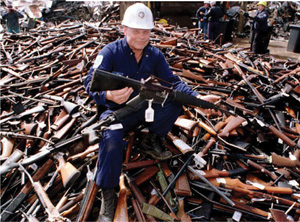
A pile of rifles handed in for scrap in Melbourne, after Australia banned all automatic and semi-automatic rifles in the aftermath of the Port Arthur shooting, 1996.
In recent decades, there has been a rise in carefully choreographed attacks on schools around the world. No matter where the events have unfolded, the psychopathy and characters involved have been startlingly similar.
Typically, the perpetrator has been a young male. Of the 101 school shootings worldwide between 1974 and 2007, only four were committed by females, according to Frank J. Robertz, cofounder of Berlin’s Institute for Violence Prevention and Applied Criminology.
While many young people fantasize about wreaking revenge on schoolmates for perceived wrongs done them, shooters are extremely disturbed individuals who suffer from various psychoses, psychopathy, and trauma. As they become consumed by out-of-control emotions, they gradually lose any sense of empathy; ultimately, they become cold-blooded and methodical, often planning their attacks down to the smallest detail.
Among adolescents considered at risk for such behavior are those who have experienced violence; they can develop brutal fantasies as a way to gain recognition and respect, says clinical psychologist Al Carlisle, a youth-violence researcher in Price, Utah. The ubiquitous media scrutiny of school shooters such as Eric Harris and Dylan Klebold, perpetrators of the 1999 Columbine High massacre, also can feed a desperate yearning for recognition in violence-prone individuals with low self-esteem.
Copycats Across the Sea
Harris and Klebold, for example, were heroes of Sebastian Bosse, an emotionally disturbed 18-year-old living in Emsdetten, Germany. In November 2006, Bosse posted a video message online: “I can’t f—kin’ wait until I can shoot every mother-f—kin’ last one of you.” After driving to his former high school armed with rifles and homemade bombs, Bosse fired randomly, injuring 37 students and teachers before committing suicide.
Similarly, Harris is thought to have inspired Pekka-Eric Auvinen, the 18-year-old from Finland who became the second school shooter in Finland’s history when he massacred eight and wounded one at Jokela High School in November 2007. Eleven others were injured by flying glass, and Auvinen shot himself in the head. In a rambling online message two weeks before the deadly attack, Auvinen wrote, “I, as a natural selector, will eliminate all who I see unfit, disgraces of human race and failures of natural selection.” The t-shirt that Eric Harris wore at the Columbine massacre read “Natural Selection.”
Thomas Hamilton, the unemployed Dunblane, Scotland, shopkeeper who killed 16 kindergarteners and an adult on March 13, 1996, is believed to have inspired Martin Bryant, the Australian mass murderer who slew 35 tourists and injured 23 others a few weeks later on a rampage in Port Arthur, Tasmania.
REMEMBERING THE DEAD
While nothing can ever replace a lost loved one, a number of towns have honored victims with moving public memorials
Dunblane, Scotland. To commemorate the 1996 Dunblane Primary School massacre, relatives in 1998 dedicated a garden at the cemetery where most of the victims are buried. Mick North, whose daughter was among the slain, described the memorial: “Thecheerfulness and brightness of a classroom is evoked by each one of the pebbles in the pools. You can almost hear the chatter of children in the sound of the fountain.” Three years later, a commemorative tablet was unveiled for the town’s cathedral. Among the quotations inscribed on it is W.H. Auden’s “We are linked as children in a circle dancing.”
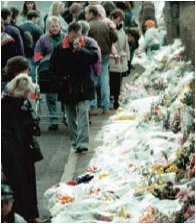
Flower tributes line the road leading to the Dunblane Primary School.
Beslan, Russia. Memorials to the more than 330 victims of the 2004 three-day Chechen separatist school siege in Beslan, Russia, have been erected in several cities. In Beslan, a structure inspired by a mourning wreath now encircles the destroyedgymnasium, the center of the tragedy. In a sculpture in the Church of Nativity square in Moscow, bronze slabs suggesting monumental stairs rise from a memorial plaque. The steps transform into human shapes, and finally into a flock of birds.

The Australian government mandated that would-be buyers declare a “genuine reason” for needing a firearm.
ANTI-GUN LEGISLATION AND POLITICAL REFORMS
Many countries have responded to school violence and other mass shootings with regulations meant to stem the tide.
• Australia: After a rampage by a deranged gunman killed 35 in Port Arthur, Tasmania, the Australian government outlawed private gun sales. An aggressive buyback program yielded some 600,000 weapons. Reports show that gun-related homicides subsequently fell by 59 percent.
• Great Britain: Following the 1996 massacre in Dunblane, Scotland, a virulent anti-gun-ownership campaign culminated in a petition with almost 750,000 signatures. By fall 1997, lawmakers had banned private ownership of handguns.
• Russia: In 2004, Chechen rebels staged a siege of a school in Beslan, Russia; 334 people were killed and more than 700 wounded. Following the massacre, the national legislature approved sweeping counterterrorism measures centralizing control over Russia’s various regions.
• European Union: In 2007, after a spate of deadly shootings, legislators backed new gun regulations. Each member state is required to maintain a database of all firearm owners.